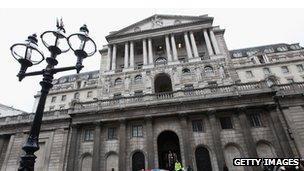Funding scheme helping bank lending, says Bank of England
- Published

The scheme aimed to halt the decline in lending in the UK
Lending from banks taking part in the Funding for Lending scheme (FLS) gathered pace in the second quarter of the year, the Bank of England has said.
However, the increase was due to a pick-up in mortgage lending, as business lending fell during the three-month period to the end of June.
The scheme was launched just over a year ago, in an attempt to boost lending and get the economy growing.
The Bank said that lending since FLS began had been "broadly flat".
Conditions 'steadily improving'
Under the scheme, banks and building societies are allowed to borrow money cheaply from the Bank of England, providing they then loan that money to individuals or businesses.
The Bank said the scheme aimed to encourage more lending to the UK economy than would have been the case in the absence of the project.
The figures show net lending, external by the 41 banks and building societies participating in the scheme was up by £1.6bn during the quarter. However, the cumulative figure over the year was down by £2.3bn.
"The FLS is continuing to support lending to the UK economy with a range of indicators suggesting that credit conditions are steadily improving for households and firms, and FLS participants collectively expect net lending volumes to pick up over the remainder of this year," said Paul Fisher, executive director for markets at the Bank of England.
Business lending
The increase in net lending in the three months to the end of June reverses a trend of falling lending over the previous two quarters.
Greg Clark, Financial Secretary to the Treasury, said: "The Funding for Lending Scheme has helped to make loans cheaper and more easily available supporting an increase in lending to the real economy and helping businesses that want to expand and families that aspire to own their own home."
However, some commentators have pointed to the concentration on mortgage lending, where the availability of cheaper mortgages has increased, especially for new homeowners.
"The Funding for Lending scheme has bathed the mortgage market in cheaper credit, but has left the small and medium enterprise market parched and arid," said Richard Sexton, director of E.surv chartered surveyors.
The British Chambers of Commerce (BCC) said this situation was particularly acute for new businesses.
"Unfortunately the door often remains shut for many of these businesses who can find themselves being discouraged from applying for finance. Those who do apply are often turned down for being too high risk," said Adam Marshall, director of policy at the BCC.
There has been a similar trend in previous months. Consequently, in April, the Bank announced additional incentives to participants to lend to small and medium-sized businesses.
Repaying funds
The latest figures show that the UK's biggest banks did not take advantage of the cheap funds available through the scheme in the second quarter of the year, and Santander actually paid back £900m of funds from the scheme.
Lloyds Banking Group increased its net lending in the second quarter of 2013 after reducing it during previous months. Over the past year, its net lending has fallen - which means it has received more repayments than it has lent out in new loans.
Santander and RBS also saw net lending fall over the past year. Barclays and Nationwide increased their net lending over the same period.